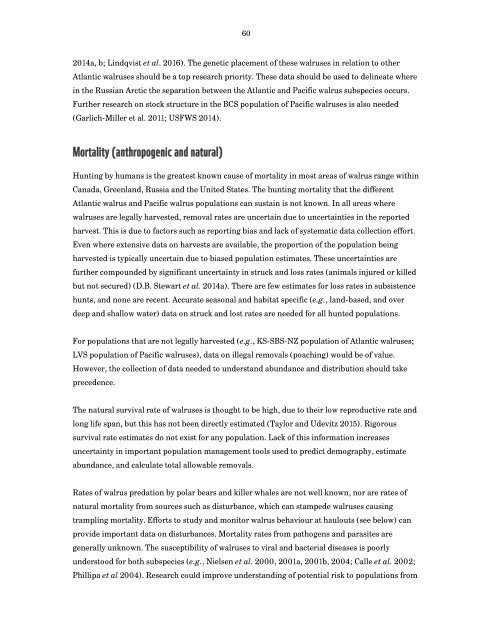The State of Circumpolar Walrus Populations
walrusreport
walrusreport
Create successful ePaper yourself
Turn your PDF publications into a flip-book with our unique Google optimized e-Paper software.
60<br />
2014a, b; Lindqvist et al. 2016). <strong>The</strong> genetic placement <strong>of</strong> these walruses in relation to other<br />
Atlantic walruses should be a top research priority. <strong>The</strong>se data should be used to delineate where<br />
in the Russian Arctic the separation between the Atlantic and Pacific walrus subspecies occurs.<br />
Further research on stock structure in the BCS population <strong>of</strong> Pacific walruses is also needed<br />
(Garlich-Miller et al. 2011; USFWS 2014).<br />
Mortality (anthropogenic and natural)<br />
Hunting by humans is the greatest known cause <strong>of</strong> mortality in most areas <strong>of</strong> walrus range within<br />
Canada, Greenland, Russia and the United <strong>State</strong>s. <strong>The</strong> hunting mortality that the different<br />
Atlantic walrus and Pacific walrus populations can sustain is not known. In all areas where<br />
walruses are legally harvested, removal rates are uncertain due to uncertainties in the reported<br />
harvest. This is due to factors such as reporting bias and lack <strong>of</strong> systematic data collection effort.<br />
Even where extensive data on harvests are available, the proportion <strong>of</strong> the population being<br />
harvested is typically uncertain due to biased population estimates. <strong>The</strong>se uncertainties are<br />
further compounded by significant uncertainty in struck and loss rates (animals injured or killed<br />
but not secured) (D.B. Stewart et al. 2014a). <strong>The</strong>re are few estimates for loss rates in subsistence<br />
hunts, and none are recent. Accurate seasonal and habitat specific (e.g., land-based, and over<br />
deep and shallow water) data on struck and lost rates are needed for all hunted populations.<br />
For populations that are not legally harvested (e.g., KS-SBS-NZ population <strong>of</strong> Atlantic walruses;<br />
LVS population <strong>of</strong> Pacific walruses), data on illegal removals (poaching) would be <strong>of</strong> value.<br />
However, the collection <strong>of</strong> data needed to understand abundance and distribution should take<br />
precedence.<br />
<strong>The</strong> natural survival rate <strong>of</strong> walruses is thought to be high, due to their low reproductive rate and<br />
long life span, but this has not been directly estimated (Taylor and Udevitz 2015). Rigorous<br />
survival rate estimates do not exist for any population. Lack <strong>of</strong> this information increases<br />
uncertainty in important population management tools used to predict demography, estimate<br />
abundance, and calculate total allowable removals.<br />
Rates <strong>of</strong> walrus predation by polar bears and killer whales are not well known, nor are rates <strong>of</strong><br />
natural mortality from sources such as disturbance, which can stampede walruses causing<br />
trampling mortality. Efforts to study and monitor walrus behaviour at haulouts (see below) can<br />
provide important data on disturbances. Mortality rates from pathogens and parasites are<br />
generally unknown. <strong>The</strong> susceptibility <strong>of</strong> walruses to viral and bacterial diseases is poorly<br />
understood for both subspecies (e.g., Nielsen et al. 2000, 2001a, 2001b, 2004; Calle et al. 2002;<br />
Phillipa et al 2004). Research could improve understanding <strong>of</strong> potential risk to populations from


